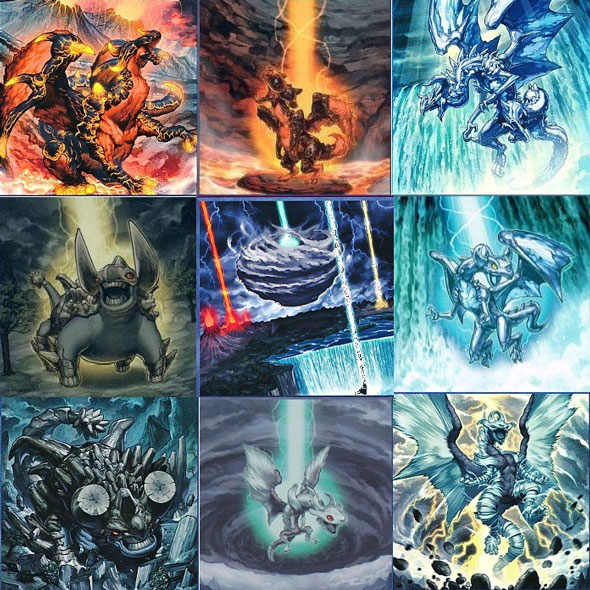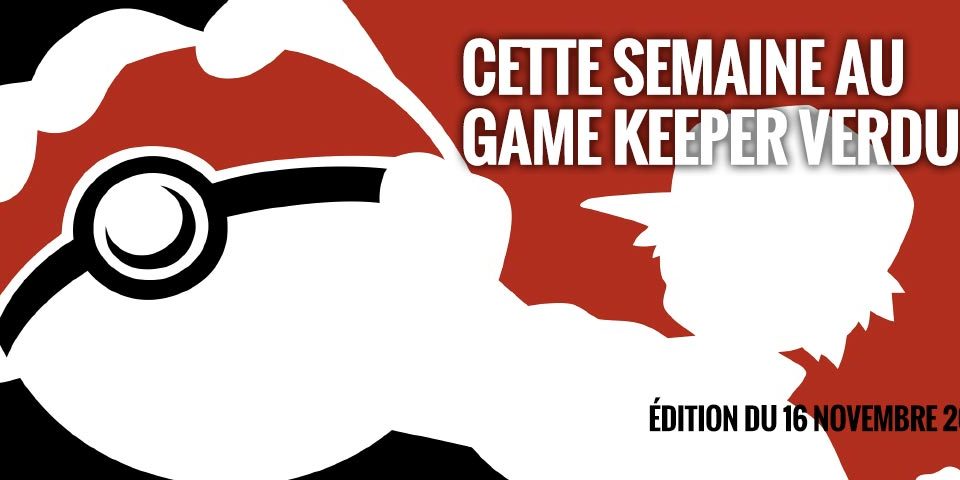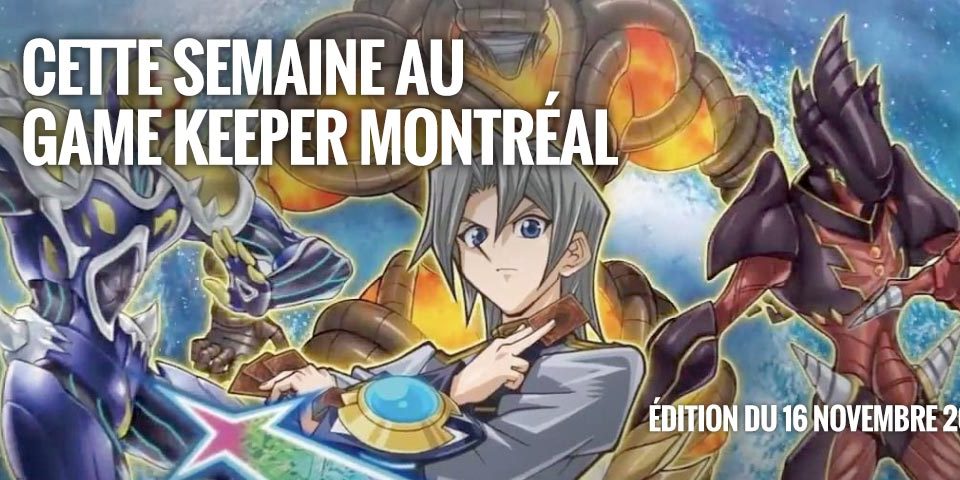Grand Prix Las Vegas
2013/06/10Exploiter la Descendance
2013/06/24Hello to the Gamekeeper community, my name is Jordan, and I’m here with a brand new article to tell you about my new favourite deck: Dragon Rulers. Anyone who knows me, knows that my specialty in Yu-Gi-Oh is building decks that require very little traps and place more emphasis on hand traps. For instance, I achieved plenty of success when Lightsworn was the best deck in Yu-Gi-Oh because it relied on very few traps (Beckoning Light), and plenty of hand traps ( Gorz, 3 Tragoedia, 3 Honest). Further success came when Chaos Dragon came along because they, too, were a deck with little to no reliance on backrow, and placed more emphasis on spamming big monsters and controlling my opponent’s plays through cards like Maxx “C” and Effect Veiler.
In this article, I’ll take a look at the newest archetype in Yu-Gi-Oh: Dragon Ruler. I believe this deck has the potential to be one of the most broken decks of all time. Although some people may accuse this deck of being an auto-pilot deck, I believe that it takes plenty of skill to play properly and effectively.
The deck is made up of 3 core components. The first component is the dragons. The second is the dragon support. The third and final component are the spells and traps which are crucial in making the deck as successful as it is. In this article, I’ll look at each component and I’ll elaborate on the Extra Deck in my video (and I’ll put my decklist in the video as well as a bonus). As for the side deck, I change my mind for the side
The Dragon Rulers
Let’s look at the very first component: The Dragons. This component is made up of two different sections – that is, the mini dragons, and the big dragons.
The big dragons have 3 common effects and one different effect, contingent on the condition that only one of the effects can be used only once per turn. The 3 common effects are:
• If this card is in your hand or Graveyard: You can banish a total of 2 [same attribute as the card] and/or Dragon-Type monsters from your hand and/or Graveyard, except this card; Special Summon this card.
• During your opponent’s End Phase, if this card was Special Summoned: Return it to the hand.
• If this card is banished: You can add 1 [same attribute as the card] Dragon-Type monster from your Deck to your hand.
So let’s analyse each effect. The first effect allows you to special summon the big dragon (Redox, Tempest, Tidal, Blaster) by banishing any combined total of 2 dragons, 2 cards of the same attribute, or one of each from your grave or hand. Notice that if you banish another big dragon, you can use the third effect of the big dragon you banished to add 1 dragon-type monster of the same attribute to your hand.
Next, during the opponent’s end phase, if you special summoned a big dragon, it returns to your hand at the end phase. Be careful, if you tribute summon it, it will not return to your hand at your opponent’s end phase. What neat about this effect is that it lets protect yourself from an OTK (instead of returning to your hand at your end phase), and these dragons are formidable walls that will be hard for your opponent to get over. Once they return to your hand, you can special summon them with little or no effort on your own turn again.
Finally, the third effect they have in common allows you to add a dragon-type monster with the same attribute to your hand when it is banished. This will have a very good interaction with the smaller dragons, as the little dragons are important in filling up your graveyard and helping you prepare your field.
Now, we move on to each one of the big dragons’ individual effects. The two more important ones are Redox and Blaster. By discarding a card of the same attribute along with the matching dragon, you can activate some very game changing effects. Blaster lets you destroy any card on the field, and Redox acts as a Monster Reborn. Tidal works as a foolish burial, and Tempest like a Stratos for a dragon monster.
So, we now know about the broken effects of the big dragons, but what do the small one’s do? Each of the small dragons lets you discard a dragon or a card of the same attribute to special summon the big version of that card from the deck. Each mini dragon also has the impediment that prevents you from using the effect of each smaller dragon more than once per turn. Also, the big dragon you special summoned cannot attack for that turn.
The Support
There are several support cards which are candidates for inclusion in the main deck. Here is a list of the main support monster cards you will see in the deck:
Debris Dragon
Flamvell Guard
Dragunity Corseca
Yamata Dragon
Light and Darkness Dragon
Red-Eyes Darkness Metal Dragon
Eclipse Wyvern
Maxx “C”
Effect Veiler
Droll & Lock Bird
Swift Scarecrow
Electric Virus
Exploder Dragon
Tsukuyomi
Debris Dragon is an a card that will let you clear the field with Black Rose Dragon or, at the very least, help you make a level 7 monster which will help you xyz into a rank 7 monster. A Wind attribute Dragon type, it has synergy with cards such as Lightning and Tempest.
Flamvell Guard is a tuner and a Fire attribute Dragon Type. Synchro summoning is very important in dragons, and a card such as Flamvell Guard lets you do just that (without wasting an effect veiler). Moreover, him being a fire allows for some neat synergy with Blastr, especially when you desperately need to destroy a certain card that I a hindrance (Ophion, Imperial Iron Wall). Dragunity Corseca has similar applications to Flamvell Guard, (being a Wind/Tuner/Dragon), except it better synergizes with Tempest and Lightning.
Yamata Dragon is a cool card which, when you inflict damage to your opponent, let’s you draw to 5 cards in hand. Although a very neat effect, Yamata Dragon seems to be falling out in favor to certain other “boss” monster such as Light and Darkness Dragon and Red-Eyes Darkness Metal Dragon.
Light and Darkness Dragon has a great stun element to it that can win the game by itself if your opponent does not have the necessary cards to counter it. Although my personal version of the build plays around Light and Darkness Dragon quite eloquently, this card is very difficult to deal with if you don’t main deck hand traps and Breakthrough Skill (or Forbidden Chalice). Whenever Light and Darkness Dragon is destroyed, it special summons a monster from your graveyard, making dealing with it a huge threat if you can’t deal with whatever it brings out!
Red-Eyes Darkness Metal Dragon is an OTK enabler which has great synergy with the deck. Although many people cut this card from their deck in favor of more consistency, this is a card which can usually win you the game when it is played.
Eclipse Wyvern, other than having incredible synergy in the deck as a dragon, also lets you use its effect to banish Red-Eyes Darkness Metal Dragon or even Light and Darkness Dragon from your deck. You can then add these cards to your hand when you banish Eclipse Wyvern for the effect of one of your “big dragons”. You can use the effect of Tidal to send Eclipse Wyvern from your deck to grave to speed up the process, or search it out with Tempest.
Effect Veiler is probably the most important card in the deck alongside Breakthrough Skill and Super Rejuvenation. Effect Veiler is crucial in stopping a Dracossack or Big Eye Push, and it stop your opponent’s Crimson Blader from causing much damage. Being a tuner, this card also allows you to go into your multitude of level 8 synchro options, which I’ll discuss later in the article.
Maxx “C” has many applications in this deck. Notably, it helps in nullifying the pushes that Mermail decks make, and it puts your opponent under pressure in the mirror match. Being an earth monster, Maxx “C” also has synergy with Redox and Reactan, making it an overall solid choice to be at 3 in your main deck.
Droll & Lock Bird is a very peculiar tech that some may find strange at first glance. Droll & Lock Bird is, perhaps, one of the best innovations in the deck, and innovation that I’ve helped propagate on online forums and in the local community. Granted that it has a huge upside in the Spellbook matchup, this card is great in the Mermail and mirror matches as well. Whenever Mermail players use the effect of Abyssmegalo, Abysspike or Abyssteus, discarding Atlantean Dragoons, this is where Droll&Lock shines best. Droll&Lock will let them search sphere or a level 4 or lower mermail, but it will not allow your opponent to search a card off of Dragoons. A lost search of Dragoons can be particularly crippling to a Mermail player. In the mirror match, Droll&Lock bird has some rather monumental applications as well. Going second, you are often faced with having to respond to your opponent’s play while they place you under the lingering effect of Maxx “C”. As such, being able to use Droll&Lock bird only let’s them draw on the first instance, and they will no longer draw under Maxx “C”. As a result, you are effectively allowing yourself to respond to a Dracossack on your opponent’s side of the field (or any threat, for that matter) without allowing your opponent to draw 3-4 cards. Droll&Lock Bird also makes certain cards such as Gold Sarcophagus, Super Rejuvenation, and Seven Star Sword less effective in the mirror match as it restricts your opponent to not banish any “big dragons” for the rest of the turn, or not waste the effects of the “mini dragons” as Super Rejuvenation will not be able to be played. Although you may agree that outside of the Mermail, Spellbook, and Dragon matchups that Droll&Lock isn’t all too great, remember this: it is a wind monster! You can use it in the effectively with Tempest and Lightning, and it gives you more Wind monsters to work with when you’re under the effect of cards such as Gozen Match that can be an annoyance, and allow you to go into Dracossack to get rid of Gozen.
Swift Scarecrow is seeing play in Dragon Rulers because of the often quick nature of the mirror match. Leaving yourself exposed can at times mean that a tiny slip-up on your part can be game-ending. As such, Players tend to use Swift Scarecrow to reward playing on the edge. It can also turn the momentum of the match whenever your opponent has over extended, and switch the game in your favour. I am personally not a fan of this card in the main deck, as I prefer what other hands traps like Droll&Lock bird bring in the mirror match.
Another card which is beginning to see some play in the main deck, (notably, Frazier Smith is credited with this innovation) is Electric Virus. Electric Virus is generally good in the mirror match and in the Evilswarm match, arguably the top 2 played decks of the format. While great for snatching cards like Dracossack and Evilswarm Ophion, ths interesting and innovative tech is subpar vs. the Spellbook and Mermail matchups.
Exploder Dragon is a quick out to cards that can be downright difficult for you to get rid of (Evilswarm Ophion). Being and Earth/Dragon, it has numerous application in the deck, and it is generally a quick out to any monster that is bothering you. Its only downside is that it is rather slow in removing threats. Against Evilswarm, it is almost foolish to attack with is into Ophion and risk running into a Dimensional Prison. Otherwise, Exploder Dragon is an excellent card and it may perhaps see more play if Evilswarm were to move up the tier chart.
Spells and Traps
There are a multitude of spells and traps which are used in this deck, and there is much debate as to what the most optimal line-up is. Many people are choosing to drop Dark Hole, as it is not effective in the mirror match (the Dracossack token prevent Dracossack from being destroyed), in the Evilswarm matchup (Infestation Pandemic and Forbidden Dress prevent destruction of their key cards), and in the Spellbook matchup (Spellbook of Wisdom). Cards like Forbidden Lance are also seeing a lot of play in the current meta in tier 2 decks like Fire Fist.
Monster Reborn is another cards which is being cut from Dragons, as Redox is usually sufficient in acting as a pseudo-Monster Reborn. Moreover, all of the big dragons constantly revive themselves from the graveyard. In short, Monster Reborn is usually a win-more card that doesn’t necessarily enhance the strategy of the deck.
Heavy Storm is still played in the deck, however, and it is the only card which is still played in the deck from what certain players regard as the Trinity (Monster Reborn, Dark Hole, Heavy Storm). Although underwhelming in the mirror match, Heavy Storm is a game-changing cards that generally wins the game vs. the Evilswarm matchup when used.
A very popular card that has seen pplent of play in the deck is Book of Moon. Although I personally don’t run it in my build, if I had 39 cards, Book of Moon would be the 40th card. It’s a very useful card that has many applications. It lets you flip down an Evilswarm monster so your opponent can’t XYZ summon into Evilswarm Ophion, it lets you flip down a spellcaster/jowgen/kycoo making Spellbook of Fate useless, and it’s generally a very versatile card that is almost never dead.
Card Destruction is a very powerful card which, when used properly, can generate mass advantage that your opponent may simply not be able to recover from. Coupled with Super Rejuvenation, Card Destruction creates mass advantage that lower-tier decks simply can’t handle. While a decent card on the local scene, Card Destruction tends to be omitted from more competitive builds.
Sacred Sword of Seven Stars is a neat card that lets you dig deep into your deck, and generates a plus-1 for you. By banishing a level 7 dragon, you can use the effect of your big dragons to add a small or big dragon of the same attribute from your deck to your hand. Although a very broken card, you only run 1-2 in the deck, as you don’t want to banish too many big dragons too quickly. You want to keep your big dragons so you can keep summoning them each turn.
Gold Sarcophagus is a card which is being played in vastly different numbers in Dragon Rulers. While I play 3 because I like the ability to search Heavy Storm in certain matchups, others prefer to run it in 1 or 2 because the prefer to run more teched-out versions of the deck, or more copies of Sacred Sword. I personally love Gold Sarcophagus and I would never consider running it a less than 2 copies in this deck. A turn 1 Gold Sarcophagus can allow you to set the tempo of the game by searching Heavy Storm in matchups which are backrow heavy. While they may be dead late game, I tend to use Gold Sarcophagus to seach my last copy of it so I don’t draw into it.
Super Rejuvenation is the Dragon Ruler Equivalent of Spellbook of Judgement. On average, you should draw 4 cards of a single copy of Super Rejuvenation. Remember, if you run the Light and Darkness Dragon version of this deck, you will also draw off Super Rejuvenation is you tribute 2 dragons for Light and Darkness Dragon’s effect. Being a quick-play spell card, if you draw into a Super Rejuvenation off of you original Super Rejuvenation in the end phase, you can activate the new copy and draw even more cards!
There are 3 trap cards which are see play in Dragons at the moment. The one which is generally played in all versions of the deck is Breakthrough Skill. Breakthrough Skill is perhaps the format defining card as it allows Dragons to play defensively on their opponent’s turn, and very aggressively during your turn. Being able to turn off the continuous effect of Evilswarm Ophion, or Jowgen the Spiritualist is crucial to Dragon Rulers, as it allows you to completely blow past them in spite of their effects which may otherwise be a hindrance. I could probably write an article itself on the usefulness and importance of Breakthrough Skill, but I will limit myself to saying that Breakthrough Skill is simply the best trap card in Yu-Gi-Oh right now.
Another card which is seeing play, notably in the OCG, is Eradicator Epidemic Virus. Although seemingly gimmicky at first site, an EEV that is executed on turn 1 is devastating for Spellbooks, and it can single-handedly win you the game. I personally choose to side 3 Eradicators as I feel that 3 Droll&Lock Birds in the main deck is enough for the Spellbook Matchup in game 1.
Finally, the third trap card that is seeing play in this deck is Return from the Different Dimension. Activating this card usually means game in the mirror match, as it allows for a consistent way to OTK or, at the very least, establish a fearsome field presence that your opponent might not be able to recover from.
Side Deck
I will not share my side deck for 2 reasons. 1) I am constantly changing my side deck and 2) I believe the side deck is very personal and, like the main deck, should be based around your
own play style. I will, however, leave a few cards that are commonly used in the side deck.
Monsters:
Swift Scarecrow
Droll & Lock Bird
Obelisk the Tormentor
Electric Virus
Exploder Dragon
Tsukuyomi
Light and Darkness Dragon
Vanity’s Fiend
Penguin Soldier
Ryko, Lightsworn Hunter
Spells:
Book of Eclipse
Mystical Space Typhoon
Traps:
Royal Decree
Eradicator Epidemic Virus
Anti-Spell Fragrance
Conclusion
I hope that you enjoyed reading my article, despite its length and submersive nature. I tried to analyze the deck with as much detail as possible in the effort to convince you to play the deck and explain why this deck is my personal choice heading into the 2013 North American World Championship Qualifier in Chicago Illinois.
You can see my build and my extra deck at the following link:
http://www.youtube.com/watch?v=ADUSMVCDD_k
Cheers, and I look forward to writing my next article for you all to read!




